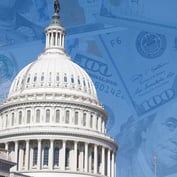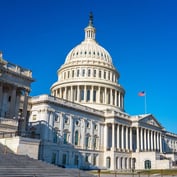While the influence of the COVID-19 pandemic continued in 2021, other news and trends in financial services came to dominate headlines.
Much of the most significant news of 2021 concerned President Joe Biden — such as his tapping of Gary Gensler to lead the Securities and Exchange Commission — and potential changes in tax rules that aim to raise government funding for different economic and social programs.
But the rising popularity of Bitcoin and other cryptocurrencies also made waves, as the financial markets generally remained robust.
Over the past year, though, prices have risen due to supply chain and related issues. This led to a higher Social Security cost of living adjustment, for instance, and there will be a hike in Medicare premiums, too. There also have been numerous discussions in Congress about the impact of potential tax changes on retirement plans, including Roth IRAs.
Meanwhile, several high-profile criminal cases and other scandals in the broker-dealer space attracted lots of attention on social media and beyond. There also have been lots of shifts tied to the $22 billion Schwab-TD Ameritrade deal of 2020, as well as numerous mergers and acquisitions this year in the rapidly consolidating financial services industry.
The following 2021 highlights reveal several trends and key industry developments that should carry over into 2022 for financial advisors, financial services firms and their investor clients. They also illustrate the rapid pace of change in the industry and the need for advisors to keep up.
Washington News
Hoping to shore up Social Security — at least for a while — House Ways and Means Social Security Subcommittee Chairman John Larson, D-Ct., introduced on Oct. 26 new legislation, Social Security 2100: A Sacred Trust, and planned to hold a hearing on the bill in November followed by a markup.
While the legislation isn’t likely to pass in 2021, it sets up debate over how to strengthen Social Security benefits and the financing of the program in 2022. “It’s been 50 years, let me repeat that, 50 years since Congress has enhanced Social Security benefits and 38 years since it has taken any comprehensive action,” Larson said in introducing the bill.
The bill adopts the Consumer Price Index for the Elderly as the basis of the annual cost-of-living adjustment (COLA), applies the payroll tax to wages above $400,000, combines the Old-Age and Survivors and Disability Insurance trust funds, includes a 2% benefits bump, and extends the depletion date (when a 20% cut to benefits would occur) to 2038.
“Here’s the deal: The majority of Americans, including 75% of independents, 78% of Democrats and 79% of Republicans feel leaders in Washington do not understand how hard it is for Americans to save for retirement,” Larson said during a press conference to introduce the bill.
“People’s skepticism is validated by Congressional inaction,” he continued. “This is compounded by the fact that 10,000 baby boomers a day become eligible for Social Security. And millennials will need Social Security more than any generation before,” he stated, adding that there are 65 million Social Security recipients.
Larson introduced the legislation along with Majority Whip James Clyburn, D-S.C.; House Ways and Means Chairman Richard Neal, D-Mass.; Sen. Chris Van Hollen, D-Md.; and other Ways and Means Democrats.
According to the bill’s fact sheet, adopting a CPI-E formula “will help seniors who spend a greater portion of their income on health care and other necessities. Improved inflation protection will especially help older retirees and widows who are more likely to rely on Social Security benefits as they age.”
The bill also includes a benefit bump for current and new beneficiaries equivalent to about 2% of the average benefit, the fact sheet explains.
Larson’s bill would require millionaires and billionaires to “pay the same rate as everyone else,” the fact sheet states. “Presently, payroll taxes are not collected on wages over $142,800.” The bill would apply the payroll tax to wages above $400,000 and “would only affect the top 0.4% of wage earners.”
Mary Johnson, Social Security and Medicare policy analyst with The Senior Citizens League, said that given the current legislative calendar, passage of the bill this year isn’t likely. “Social Security legislation requires consideration under special rules,” Johnson said. “Thus, I suspect that the provisions of this bill would need to be considered separately” from the spending bill now under debate in Congress.
Johnson added, however, that while Larson’s “entire bill” won’t be wrapped into a spending package, some provisions could make it in.
Larson’s bill, “will certainly open debate over how to strengthen Social Security benefits and the financing of the program in 2022,” Johnson added, “and we intend to continue to work with members of Congress to find the best solutions to improve program solvency and benefits for all beneficiaries.”
The Social Security 2100 bill “not only provides measures that would boost benefits, and provide better protection from inflation, but it would adjust the income thresholds that subject Social Security benefits to taxation, among a number of long overdue changes,” Johnson said.
Gary Gensler took the helm of the Securities and Exchange Commission in April 2021 and brought with him a long to-do list. With Gensler’s arrival, industry officials are holding out hope that a Bitcoin ETF finally will be approved.
Since taking charge, Gensler has aired his views on everything from the regulation of cryptocurrency, the agency’s Regulation Best Interest, as well as problems he sees with digital engagement platforms.
In remarks at the Securities Industry and Financial Markets Association’s annual conference, held virtually in October, Gensler reiterated his views that what’s important for the SEC now regarding crypto trading and lending platforms is ensuring that the investing public is protected.
In this new crypto area, Gensler stated, “there’s a lot of hype and investors reaching for yield who are hoping to have a little bit better future; but these platforms generally have not come in to either the CFTC or SEC [oversight] to be within an investor protection framework.” The SEC, Gensler said, is “going to be very active trying to bring this [crypto] market into what I’ll call the investor protection framework.”
Gensler this year also has questioned when design elements and psychological nudges associated with digital engagement platforms, or DEPs, “cross the line” and become recommendations.
“The answer to that question is important, because that might change the nature of the platform’s obligations under the securities laws,” Gensler said at the Practising Law Institute’s SEC Speaks event.
“Even if certain practices might not meet the current definition of recommendation, I believe they raise a question as to whether there are some appropriate investor protection guardrails to consider, beyond simply the application of antifraud rules,” Gensler said.
These modern DEP features, Gensler continued, “go beyond game-like elements, or what is sometimes called ‘gamification.’ They encompass the underlying predictive data analytics, as well as a variety of differential marketing practices, pricing and behavioral prompts.” Gensler told lawmakers this year that he remains committed to continuing to implement Reg BI as it’s “written down.”
On Aug. 25, Gensler appointed Barbara Roper as his senior advisor. Roper, the former director of investor protection for the Consumer Federation of America, has been a vocal critic of Reg BI.
During a question-and-answer session with Rep. Ann Wagner, R-Mo., at an SEC oversight hearing held by the House Financial Services Committee, Wagner stated that “the benefits of Reg BI to the capital markets are abundantly clear, and there’s little doubt that investors are better off today than they were previously … You have brought on staff with a clear public record of opposing Reg BI. You can understand how that would give the investing public the impression that the SEC under your leadership is not committed to Reg BI.”
She reminded Gensler of his previous comments during his confirmation hearing that he was committed to working with SEC staff to ensure Reg BI “’lived up to its best-interest label.’” Wagner asked Gensler: “Do you still commit to fully supporting the continued implementation of Reg BI?”
Gensler responded: “That is as true today as when I said it. This will ensure that our regulations, Regulation Best Interest, and others, live up to what is written down on the page.”
During his confirmation hearing, however, Gensler also stated that the agency will “constantly evaluate” how Reg BI is serving investors and that it could be modified. “If the rule doesn’t work, ultimately, we are going to look to make sure that brokers ensure that the investing public truly gets best interest,” Gensler told lawmakers.
Investment advisors will face major changes in how they can advertise and market their services next year thanks to a new Securities and Exchange Commission rule that went into effect in May.
Former SEC Chairman Jay Clayton said when the rule passed that the new “comprehensive framework for regulating advisors’ marketing communications recognizes the increasing use of electronic media and mobile communications and will serve to improve the quality of information available to investors.”
The new rule, Clayton said, provides for “an extended compliance period intended to provide advisors with a sufficient transition period, including to enable consultation with the Commission’s expert staff.”
Registered investment advisors view the new marketing and advertising rule as the “hottest” compliance topic in 2021, according to an Investment Adviser Association poll.
The SEC’s advertising and marketing rule has been in effect since early May, but compliance experts are cautioning advisors to tread carefully when using testimonials and endorsements before the rule’s Nov. 4, 2022, compliance date.
The use of testimonials and endorsements “before the firm is fully compliant and updating its compliance [policies and procedures] … that is a huge risk to the firm,” Amy Lynch, founder and principal of FrontLine Compliance, said on a webcast held by ThinkAdvisor.
Daren Domina, a partner in the Investment Management and Private Equity Practice Groups at Haynes and Boone in New York, who also heads the Broker-Dealer Regulatory Practice Group, added that “because of the Marketing Rule’s permissibility of use, I expect to see more advisor arrangements and presentations with testimonials and endorsements, including increased use of social media.”
In October, the SEC announced that investment advisors can no longer rely on a host of SEC staff letters that provided guidance on how to comply with the agency’s current advertising and cash solicitation rules.
The SEC’s Division of Investment Management recently issued an update on its new Marketing Rule, amended Rule 206(4)-1, stating that it was rescinding a bevy of SEC Staff Letters that provided guidance.
“Many of the positions taken in those guidance documents have been incorporated into the rule and others have been modified or rejected,” the SEC’s IM division said.
Retirement News
On Oct. 13, the annual cost-of-living adjustment, or COLA, for Social Security benefits in 2022 was announced by the Social Security Administration: 5.9%. This will be the largest increase since 1982.
“This would be the highest COLA that most beneficiaries living today have ever seen,” said Social Security and Medicare policy analyst Mary Johnson of The Senior Citizens League, noting that inflation patterns caused by the COVID-19 pandemic are “unprecedented” in her experience.
The COLA was based on third-quarter inflation data, and spotlighted rising inflation. The Consumer Price Index, announced that morning by the Labor Department was up 5.4% in September versus the year prior and up 0.4% from August. (The CPI includes food and energy.)
Key components of the increase included the energy index, which rose 1.3 % from the previous month, mainly due to the gasoline index, which rose 1.2%, and fuel oil, which rose 3.9%. The food index rose 0.9%, and new vehicle prices increased 1.3% from the previous month.
“Over the past 21 years, COLAs have raised Social Security benefits by 55% but housing category costs rose nearly 118% and health care costs rose 145% over the same period,” Johnson said. In other words: A Social Security benefit that grew to $1,262.40 per month in 2021 from $816 in 2000 should have grown to $1,671 to keep up with rising costs, according to the advocacy group.
However, Stephen Goss, SSA chief actuary, during a panel discussion held by the Bipartisan Policy Center directly after the announcement, warned that people shouldn’t expect big annual COLA raises to become a trend.
Further, he said that just as important as the COLA was the average wage index or AWI, as it affects how benefits are calculated at retirement age. “That’s significant because individuals becoming newly eligible for benefits in 2022 will have their benefit formula adjusted by the average wage index,” Goss said, adding that a year or so ago before the pandemic took hold, many didn’t expect the AWI to rise.
Although many factors are affected by this increase, he said, one is the taxable maximum dollar amount that will be adjusted, up to $147,000. Goss made clear the AWI, which is based on actual 2020 W-2 forms from all U.S. wage earners, increased 2.8% from a year earlier. Regarding the current COLA, Goss stated that “anybody who is currently in receipt of benefit obviously should take a look at what their benefit is and imagine what a 5.9% increase will do to that benefit level.”
Goss also explained that in 2008, during the third quarter “we had this large increase in fuel prices that really created, largely, that 5.8% COLA by December of that year, and then prices dropped back pretty substantially. And because of that drop back … there was a much lower CPI over the next couple of years,” he said.
However, for now, he says indicators show in the future “we’re not likely to have a dramatic correction down … we’ll probably have COLAs but [they] might be smaller than we would otherwise expect.”
The September release of the Social Security Trustees report — long in coming as it is typically released in April — had potential bad news: The projected date that the Old-Age and Survivors Insurance Trust Fund, which pays benefits to retirees, was to be depleted by 2033, one year earlier than reported in 2020.
The Disability Insurance Trust Fund will pay benefits until 2057, eight years earlier than last year’s report. Once the funds are depleted, the OASI should be able to pay 76% of scheduled benefits, while the DI will pay 91% of scheduled benefits.
But this is better than some retirement experts feared at the height of the pandemic. “The news from the new report was definitely less dire than many thought could be possible,” Wade Pfau, professor of retirement income at The American College of Financial Services, told Investment Advisor. ”Last year’s report projected that the combined OASDI funds could be depleted by 2035. During the pandemic, there was analysis circulated that this date could be moved to as early as 2029. In the end, it’s only one year sooner at 2034.”
The depletion date isn’t written in stone. But Congress will have to take action.
“[Last year] saw a reduction in payroll taxes collected, but also an increase in expected mortality among Social Security recipients,” Michael Finke, professor and Frank M. Engle Chair of Economic Security Research at The American College of Financial Services, told Investment Advisor.
“Neither had a big impact on solvency projections, since they largely canceled each other out, and you see that the modest projected reduction in the actuarial balance is the result of using different and more accurate methodology,” Finke explained.
“The bottom line is that we’ve known for years that either taxes collected will need to rise, benefits will need to be reduced, or inflation adjustments will need to be more modest,” he added. “It’s more than likely that politicians will wait as long as possible before making the hard choices, but the alternative of a 24% benefit cut is a political death sentence.”
Jamie Hopkins, managing partner of wealth solutions at Carson Group, said in a tweet: “I’m happy SS report was better than expected but I wonder if the full impact is still a year away.”
In 1999, budding investor Peter Thiel used $1,700 in his new Roth IRA to buy startup shares of the firm he co-founded, which would later become PayPal. That account now is worth more than $5 billion — with no tax bill awaiting Thiel upon withdrawal of the assets, as long as he waits until six months before his 60th birthday.
In June, ProPublica, an investigative news outlet, reported this story in an article, “Lord of the Roths: How Tech Mogul Peter Thiel Turned a Retirement Account for the Middle Class Into a $5 Billion Tax-Free Piggy Bank.” The article sparked debate over Thiel’s use of a Roth IRA as a massive tax shelter — and how other investors and the government might respond.
Indeed, the expose ignited an array of actions from Congress, which has included an ongoing threat to the usage of the so-called mega backdoor Roth IRAs in various legislation.
The retirement planning provisions that were approved in the House Ways and Means Committee’s Build Back Better bill in mid-September were excluded from President Joe Biden’s Build Back Better framework, released on Oct. 29. However, the elimination of backdoor Roth IRA conversions made it back into the latest version of House Democrats’ tax and spending bill, which was released on Nov. 3.
In mid-November, House lawmakers were drawing close to a vote on Biden’s Build Back Better bill. But Greg Valliere, chief U.S. policy strategist for AGF Investments, said that the “growing public anxiety over inflation will become an obstacle for proponents of more federal spending.”
Senate Finance Committee Chair Ron Wyden, D-Ore., said in late July, however, that data released by the Joint Committee on Taxation showed “it’s long past time to crack down on mega-IRAs.”
The new JCT data provided an update to a 2014 Government Accountability Office report requested by Wyden. The GAO report, which used 2011 tax data, showed nearly 8,000 taxpayers had aggregate IRA balances of $5 million to $10 million. A total of more than 9,000 taxpayers had $5 million or more.
“The new JCT data show a threefold increase in aggregate IRA balances of $5 million or more,” the lawmaker said.
As of the 2019 tax year, nearly 25,000 taxpayers had aggregate IRA balances of $5 million to $10 million. In total, more than 28,600 taxpayers had more than $5 million, including 497 taxpayers with aggregate IRA balances of $25 million or more, the JCT found. The average aggregate account balance for these 497 taxpayers was more than $150 million.
“It is shocking, but not surprising, to see how the use of mega-IRA accounts by mega-millionaires and billionaires has exploded,” Wyden said at that time. “IRAs were designed to provide retirement security to middle-class families, not allow the super wealthy to avoid paying taxes. This is the perfect example of what I’ve long called the tale of two tax codes.”
Thiel’s purchase of founders’ shares and hedge fund investments within his Roth IRA might not have been a prohibited transaction when initiated, but the way those shares were valued could draw the attention of tax authorities, said Buckingham Wealth Partners Chief Planning Officer Jeff Levine, CPA and CFP.
“It wasn’t a prohibited transaction when he made the initial purchase,” Levine told Investment Advisor at the time. “[However] I could see some potential prohibited transaction concerns when he had a liquidity event and may have used some of that [Roth IRA] money to invest in his own hedge fund.”
He noted that “there is more to unpack there, and unfortunately we don’t have all the details.” But “there are several strong pieces of evidence that the shares [Thiel bought] were not valued properly,” Levine said.
The key evidence was a PayPal filing with the Securities and Exchange Commission stating that these shares were undervalued when Thiel bought them. He paid, according to ProPublica, a fraction of one cent for each share.









 November 23, 2021 at 10:37 AM
November 23, 2021 at 10:37 AM











